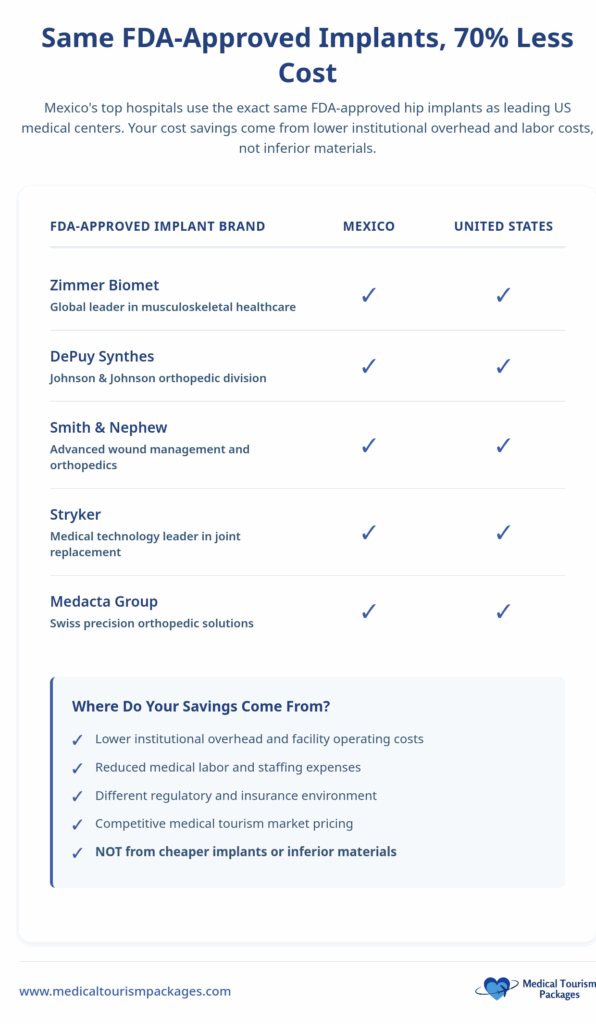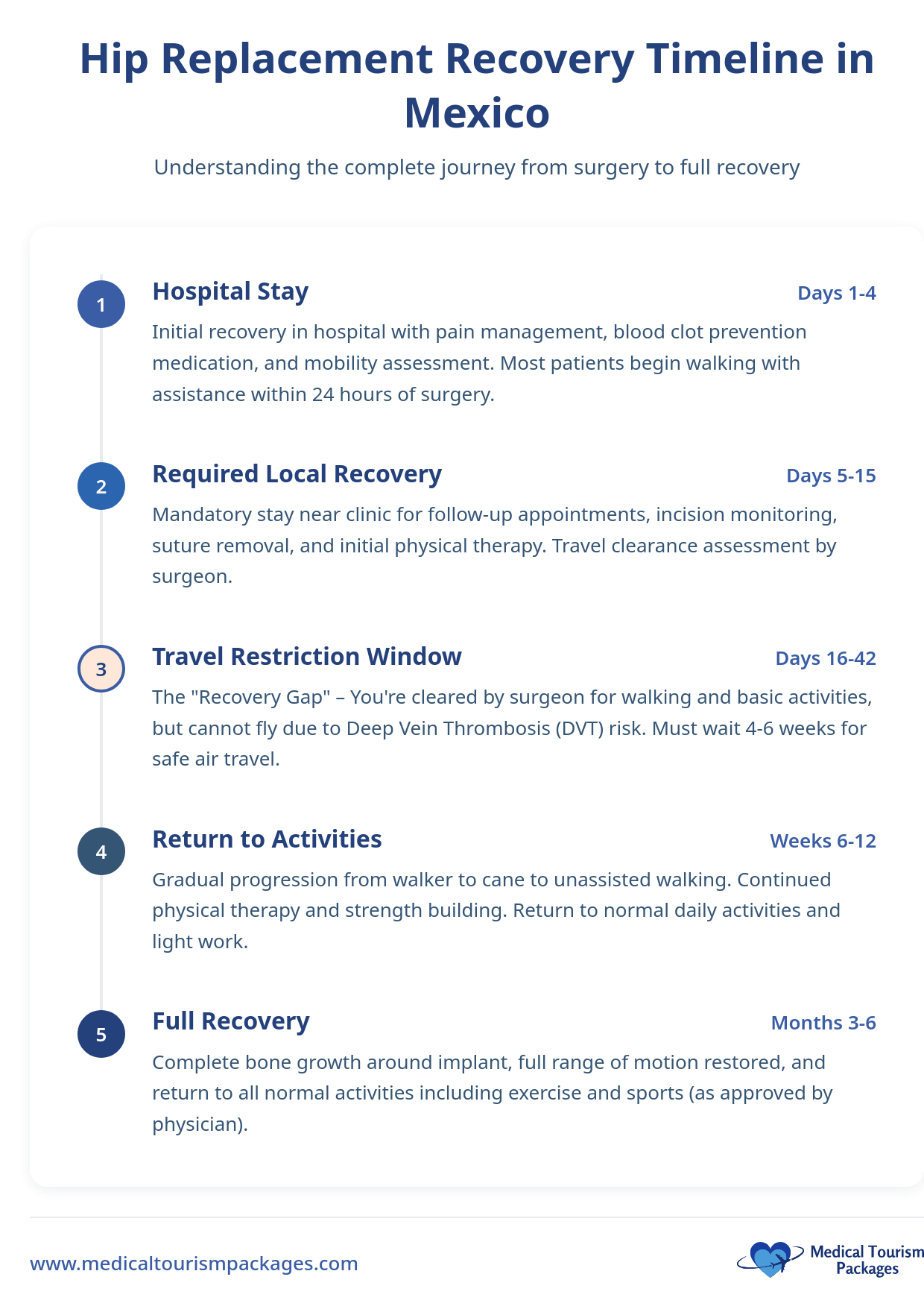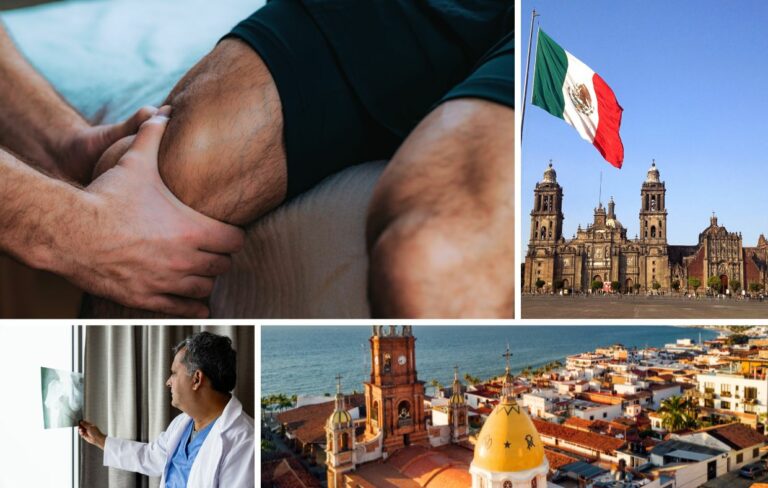Book Appointment Now

Hip Replacement Surgery in Mexico: Complete Guide, Costs, and Best Locations for Medical Tourists
Hip replacement surgery can restore your mobility and eliminate chronic pain, but in the United States and Canada, the procedure often costs between $40,000 and $100,000. For many patients, these prices remain out of reach even with insurance coverage.
Mexico has emerged as a compelling alternative for patients seeking quality care at affordable prices. You can receive the same surgery from board-certified orthopedic surgeons for 60-70% less than what you would pay at home. Top Mexican hospitals use FDA-approved implants and adhere to the same international safety standards you’d expect from facilities in North America.
This guide walks you through everything you need to make an informed decision about hip replacement surgery in Mexico, from evaluating costs and surgeon qualifications to planning your recovery.
What Is Hip Replacement Surgery?
Hip replacement, medically known as hip arthroplasty, involves removing damaged bone and cartilage from your hip joint and replacing it with artificial components called prostheses. The procedure relieves chronic pain, restores joint function, and improves your quality of life when conservative treatments no longer work.
Your orthopedic surgeon removes the damaged portions of your hip joint and replaces them with prosthetic components typically made from medical-grade metal, ceramic, or durable plastic. The entire procedure usually takes one to two hours.
Several types of hip replacement procedures offer substantial savings in Mexico compared to the United States. Hip replacement is one of the most common orthopedic surgeries performed for medical tourists:
| Procedure Type | Cost in Mexico | Cost in US | Savings |
|---|---|---|---|
| Total Hip Replacement | $7,000–$16,000 | $30,000–$65,000+ | 50%–89% |
| Partial Hip Replacement | $4,500–$7,500 | $30,000–$50,000 | 75%–91% |
| Hip Resurfacing | $8,000–$15,000 | $30,000–$50,000 | 50%–84% |
| Revision Hip Replacement | $10,000–$18,000 | $30,000–$100,000 | 40%–90% |
| Robotic-Assisted (MAKO) | $12,000–$18,000 | $30,000–$100,000+ | 40%–88% |
Why Choose Mexico for Hip Replacement Surgery?
Mexico attracts between 1.4 and 3 million medical tourists annually. Hip replacement has become one of the most sought-after procedures. Three main factors make Mexico attractive: proximity to the United States, significant cost savings, and shorter wait times.
The cost advantage is substantial. You can save between 65% and 80% compared to US prices. These savings don’t come at the expense of quality. Leading Mexican facilities use the same surgical techniques found in top American hospitals. This includes MAKO robotic assistance and the Direct Anterior Approach for minimally invasive surgery.

Mexican orthopedic clinics stock FDA-approved implant brands. These include Zimmer Biomet, DePuy Synthes, Smith & Nephew, Stryker, and Medacta Group. These are the same manufacturers trusted by hospitals throughout North America and Europe. You receive the same high-grade prosthetic components regardless of where you have surgery.
Geography makes Mexico convenient. Tijuana sits just 20 miles from San Diego. This makes it an easy drive for patients from the western United States. Many major US cities offer direct flights to medical hubs like Guadalajara, Monterrey, and Cancun. The short travel time reduces stress.
Mexican facilities can schedule your surgery within weeks. This beats the months-long wait times common in the US and Canada. Canadian patients face average wait times of 32.4 weeks for hip replacement. You could be living pain-free in Mexico while still waiting for your consultation at home.
How Much Does Hip Replacement Surgery Cost in Mexico?
Hip replacement surgery in Mexico costs between $9,000 and $16,000 on average, representing a fraction of what you would pay in the United States or Canada:
| Country | Average Cost Range |
|---|---|
| Mexico | $9,000–$16,000 |
| United States | $40,000–$65,000 |
| Canada (Private) | $20,000–$35,000 |
The total package price in Mexico typically includes hospital fees ($3,000–$7,000), surgeon’s fees ($2,500–$5,000), and anesthesia and medication ($1,000–$2,000). These transparent pricing structures let you know your exact costs before you commit.
The financial advantage becomes clearer when you look at US insurance. Many American patients pay less out-of-pocket in Mexico than their US deductible alone.
Consider this example: Your plan has a $5,000 deductible plus 20% coinsurance. A $65,000 procedure in the US would cost you $13,000 or more. That same amount covers your entire surgery in Mexico, including travel expenses.
Who Is a Good Candidate for Hip Replacement Surgery?
Hip replacement becomes necessary when conservative treatments no longer work. You might need surgery if your pain continues even when resting. Walking and bending may become difficult despite treatment. Medications and assistive devices like canes may no longer provide relief. These are signs your doctor will look for when recommending surgery.
What Medical Conditions Require Hip Replacement?
Several medical conditions commonly lead to the need for hip replacement:
- Osteoarthritis – Age-related wear and tear that breaks down cartilage
- Rheumatoid arthritis – Autoimmune disease causing joint inflammation
- Osteonecrosis – Insufficient blood flow to the hip bone
- Hip dysplasia – Abnormal hip socket formation present from birth
- Traumatic arthritis – Joint damage from accidents or falls
- Hip fractures – Severe breaks that cannot heal properly
What Conditions May Disqualify You from Hip Replacement Surgery?
Certain conditions may disqualify you from surgery or require treatment first:
- Active infections – Must be resolved before elective surgery
- Smoking – Significantly slows healing and increases complications
- Severe osteoporosis – Weakened bones may not support implants
- Uncontrolled diabetes or heart issues – Require stabilization first
- Extreme obesity (BMI over 40) – Increases surgical risks substantially
- Recent heart attack or stroke – Surgery must wait until recovery
Which Mexican Cities Are Best for Hip Replacement Surgery?
Mexico offers several excellent locations for hip replacement surgery, each with distinct advantages. When evaluating facilities, look for quality indicators including international accreditations, surgeon credentials, modern equipment, and patient outcomes. While JCI accreditation is one valuable marker (only nine facilities in Mexico hold this credential), many excellent hospitals meet high standards through other verification methods.
| City | Cost Range | Access | Best For |
|---|---|---|---|
| Tijuana | $8,000–$15,000 | 20 miles from San Diego | US patients wanting minimal travel and easy family visits |
| Cancun | $9,000–$16,000 | Direct flights from most major US cities | Patients wanting beach recovery and vacation atmosphere |
| Puerto Vallarta | $8,500–$14,000 | Direct flights from US/Canadian cities | Those preferring relaxed, less commercialized setting |
| Guadalajara | $9,000–$15,000 | Good airport connections to US hubs | Patients prioritizing medical excellence and verified quality credentials |
Why Choose Tijuana for Hip Replacement Surgery?
Tijuana is the most accessible option for American patients. The city sits just 20 miles from San Diego, California. You can drive directly to your medical appointments. No airports or flight schedules to deal with. Family members from the western United States can visit easily during recovery.
Hip replacement in Tijuana costs between $8,000 and $15,000. The border location offers a key advantage. You can drive home once your surgeon clears you for travel. This avoids the four-to-six-week wait required before flying. You’ll save money on extended accommodation costs.
Why Choose Cancun for Hip Replacement Surgery?
Cancun combines world-class medical care with a vacation atmosphere. Your recovery period becomes more pleasant. The city offers direct flights from most major US cities. Travel logistics are straightforward despite the distance.
Hip replacement in Cancun costs between $9,000 and $16,000. The slightly higher cost reflects the resort location and comprehensive medical tourism infrastructure. Many patients choose Cancun to recover in a beautiful beach environment. You receive quality orthopedic care while enjoying the surroundings. Facilities are experienced in serving international patients. Bilingual support is available throughout your stay.
Why Choose Puerto Vallarta for Hip Replacement Surgery?
Puerto Vallarta offers a more relaxed alternative to Cancun. The atmosphere is less commercialized. Direct flights are available from major US and Canadian cities. The Pacific coast location provides a tranquil recovery environment. You avoid the crowds typical of larger resort destinations.
Hip replacement costs range from $8,500 to $14,000 in Puerto Vallarta. This makes it a moderately priced option. The city attracts patients who value a quieter atmosphere during recovery. You still get the convenience of a resort location. Medical facilities serve a steady stream of international patients. Staff are familiar with medical tourism protocols and patient coordination.
Why Choose Guadalajara for Hip Replacement Surgery?
Guadalajara is Mexico’s medical excellence hub. The city offers the most rigorous quality credentials among Mexican cities. As one of Mexico’s major metropolitan centers, Guadalajara hosts top-ranking hospitals. These facilities are state-of-the-art. The city has a concentration of internationally accredited institutions and highly credentialed orthopedic specialists.
Hip replacement costs between $9,000 and $15,000 in Guadalajara. Consider this city if you prioritize medical excellence over recovery location aesthetics. Guadalajara has good airport connections to major US hubs. Access is straightforward despite its inland location. Patients seeking the highest levels of institutional oversight and surgeon expertise should focus their search here.
How to Verify Quality and Safety of Mexican Hip Replacement Facilities?
Choosing a qualified facility and surgeon requires careful verification across multiple quality indicators. Look beyond any single credential to build a complete picture of safety and excellence.
Hospital Quality Indicators:
Joint Commission International (JCI) accreditation is one important marker of quality. Only nine facilities in Mexico hold this credential, including Ángeles Hospital, Galenia Hospital, and Médica Sur. Médica Sur is particularly distinguished as the first hospital outside the United States and the only one in Latin America to join the Mayo Clinic Care Network.
However, many excellent hospitals demonstrate quality through other means including modern equipment, international patient volumes, specialty certifications, and verified patient outcomes. The key is comprehensive verification rather than relying on a single credential.
Surgeon Qualifications to Verify:
- Board certification equivalent to American Board of Orthopedic Surgery – Confirms rigorous training and examination
- Advanced fellowship training in the US or Europe – Indicates specialized hip and joint replacement education
- Membership in professional organizations – Look for CMOT, AMECRA, FEMECOT, ISAKOS, or Mexican Society of Hip Surgery
- 14-25+ years of experience – Ensures thousands of procedures performed
- High volume of international patients – Critical because Mexico’s national rate is only 8 procedures per 100,000 people vs. 200 per 100,000 in the US
Don’t hesitate to ask your surgeon directly about their training, annual procedure volume, and complication rates compared to international benchmarks.
What Is the Hip Replacement Procedure Like in Mexico?
Hip replacement surgery in Mexico follows the same standardized protocols used throughout North America and Europe. Understanding the process can ease your anxiety on surgery day.
The procedure unfolds through these steps:
- IV line and catheter placement – Intravenous access for medications and urinary catheter for monitoring
- Anesthesia administration – Either general anesthesia or regional numbing from the waist down
- Incision and positioning – 6-10 inch incision for traditional surgery or 3-4 inches for minimally invasive
- Removal of damaged components – Femoral head removed and damaged bone and cartilage cleared
- Prosthetic insertion – New socket placed in pelvis, stem inserted in femur, ball component attached
- Testing and closure – Range of motion tested before closing the incision
- Recovery room – Several hours of vital sign monitoring before moving to hospital room
The entire procedure typically takes one to two hours.
What Is the Recovery Timeline for Hip Replacement in Mexico?
Recovery from hip replacement follows a predictable timeline. Planning for adequate time in Mexico is essential, as rushing home can compromise healing.
| Recovery Phase | Timeline | What to Expect |
|---|---|---|
| Hospital Stay | 2-4 days | Pain management, blood clot prevention, walking with assistance within 24 hours |
| Local Recovery | 10-15 days | Incision monitoring, suture removal, travel clearance |
| Return to Activities | 6-12 weeks | Progress from walker to cane to unassisted walking |
| Full Recovery | 3-6 months | Normal function, bone growth complete |
Most surgeons advise waiting four to six weeks before flying due to blood clot risks. Since you only need to stay near your hospital for 10 to 15 days, this creates a “recovery gap” requiring extended accommodations for an additional two to three weeks. You can either stay in Mexico or drive home after the initial period.
When flying home, wear compression stockings, walk the aisle hourly, and request an aisle seat with extra legroom.

What Are the Risks and Complications of Hip Replacement Surgery in Mexico?
What Are the Common Complications of Hip Replacement Surgery?
Hip replacement carries inherent risks regardless of location:
- Infection – Occurs in approximately 2.88% of patients at six months
- Blood clots – Can form during limited mobility periods
- Joint dislocation – Possible if you move incorrectly, especially early on
- Implant loosening – May occur after 15-20 years
- Leg length discrepancy – One leg may end up slightly different
- Nerve damage – Rare but possible
Despite these risks, 90% of patients won’t require revision surgery, meaning your implant will likely function well for decades.
What Are the Post-Operative Care Challenges After Surgery in Mexico?
The most significant challenge isn’t surgical but logistical. Many US and Canadian physicians are reluctant to provide post-operative care for surgeries they didn’t perform due to liability concerns. You must secure acceptance from a domestic healthcare provider before traveling. Contact your primary care physician and local orthopedic surgeons explicitly about follow-up care, document their agreement, and ensure your Mexican surgeon sends all records to your home care team.
What Are the Advantages of Hip Replacement Surgery in Mexico?
Understanding the benefits helps you make an informed decision:
- Cost savings of 65-80% vs. US prices
- FDA-approved implants from Zimmer Biomet, DePuy Synthes, Smith & Nephew, Stryker, and Medacta
- Modern techniques including MAKO robotic assistance
- Surgery scheduled within weeks instead of months
- Convenient proximity and direct flights
- Recovery in beautiful environments
What Are the Disadvantages of Hip Replacement Surgery in Mexico?
You must also consider significant drawbacks:
- Severe limitations on legal recourse for malpractice
- Financial exposure if complications arise
- Extended accommodation costs during recovery gap ($2,000-$5,000)
- Only nine JCI-accredited facilities
- Low national surgical volume (8 vs. 200 per 100,000 in US)
- No standardized public outcome reporting
How to Prepare for Hip Replacement Surgery in Mexico?
Proper preparation is essential for a successful medical tourism experience. Understanding the complete preparation process for American medical tourists helps ensure a smooth journey and recovery.
What Pre-Operative Requirements Are Needed?
Start organizing requirements four to six weeks before your procedure. Your Mexican medical team needs comprehensive documentation:
- Complete physical exam, blood/urine tests, EKG, chest x-rays, MRI/CT scans
- Medical records, prescriptions, referral letters with complete history
- Passport valid for six months beyond travel date
- Comfortable clothing, mobility aids, compression stockings
What Travel Arrangements Should You Make?
Arrange for a companion to travel with you. Your mobility will be significantly limited, and you’ll need assistance with basic tasks for at least the first week. Plan for a minimum 10-14 day stay post-surgery before attempting travel home.
What Are the Most Common Questions About Hip Replacement Surgery in Mexico?
How long does a hip replacement last in Mexico?
Hip implants from Mexican facilities typically last 15 to 20 years with proper care. JCI-accredited hospitals use the same FDA-approved implants from manufacturers like Zimmer Biomet, DePuy Synthes, and Stryker that US hospitals use. Longevity depends on your activity level, weight, and adherence to post-operative guidelines rather than where you have the surgery.
Can I fly home immediately after hip replacement surgery?
No. You should stay in Mexico for 10 to 15 days for initial recovery and follow-up visits. Most surgeons recommend waiting four to six weeks before flying to lower the risk of blood clots. If you live near the border, driving home earlier is possible, but air travel requires additional healing time.
Will my US insurance cover hip replacement in Mexico?
Most US and Canadian insurance plans do not cover elective procedures performed outside their countries. Expect to pay out of pocket. However, the total cost in Mexico ($9,000–$16,000) is often less than your US deductible and co-insurance would be for the same procedure.
How do I find a qualified surgeon in Mexico?
Seek surgeons affiliated with JCI-accredited hospitals and board certification equivalent to the American Board of Orthopedic Surgery. Verify advanced fellowship training in the US or Europe and membership in organizations like ISAKOS or the Mexican Society of Hip Surgery. Ask about annual procedure volume and complication rates.
What happens if I have complications after returning home?
Some US physicians are reluctant to manage complications from surgeries done abroad due to liability concerns. Arrange domestic follow-up care before traveling. Contact your primary care physician and local orthopedic surgeons to confirm they will provide post-operative monitoring, and document their agreement in writing.
Is the quality of hip implants in Mexico the same as in the US?
Yes. Leading Mexican facilities use identical FDA-approved implants from the same manufacturers that supply US hospitals, including Zimmer Biomet, DePuy Synthes, Smith & Nephew, Stryker, and Medacta Group. The hardware quality is the same; savings come from lower overhead and labor costs.
How much money can I actually save by going to Mexico?
You can save 65% to 80% compared to US prices. A total hip replacement costs about $9,000–$16,000 in Mexico versus $40,000–$65,000 in the US, yielding savings of roughly $24,000 to $49,000 even after travel, lodging, and extended recovery expenses.
Do I need a medical visa to get surgery in Mexico?
No medical visa is required for US and Canadian citizens. You can enter under standard tourist protocols with a valid passport. Ensure at least six months of validity remains and bring documentation of your medical appointments.
Is Hip Replacement Surgery in Mexico Right for You?
Choosing hip replacement surgery in Mexico is a major decision. You need the right facility, the right surgeon, and complete support throughout your journey.
Medical Tourism Packages eliminates the guesswork.
We connect you with thoroughly vetted facilities and experienced orthopedic surgeons. Every hospital and surgeon in our network undergoes rigorous credential verification. You get complete support from your first consultation to your follow-up care at home.
What You Get:
- Verified Quality – Thoroughly vetted hospitals and board-certified surgeons
- Transparent Pricing – Itemized cost estimates with no hidden fees
- Complete Coordination – Flights, 4-star accommodation, and airport transfers arranged
- On-Ground Support – 24/7 availability, translation services, and daily check-ins
- Medical Continuity – Records transferred to your US physicians for seamless follow-up care
- Peace of Mind – Emergency protocols and complication assistance included
Save 65-80% on hip replacement without compromising quality or safety.
Ready to explore your options? Contact Medical Tourism Packages today for a free consultation and personalized cost estimate.



